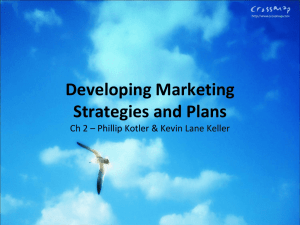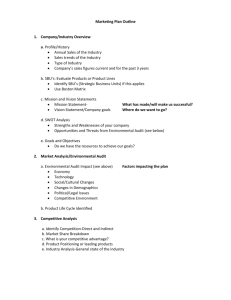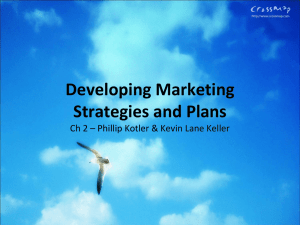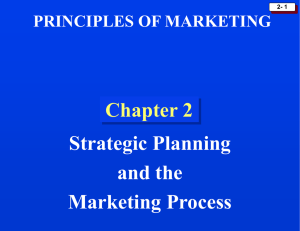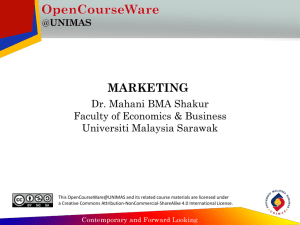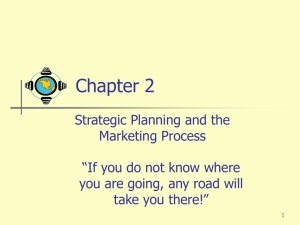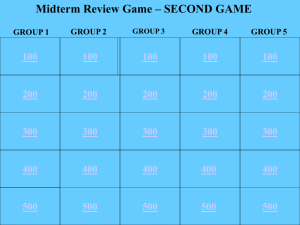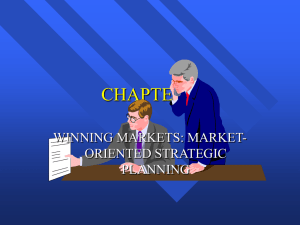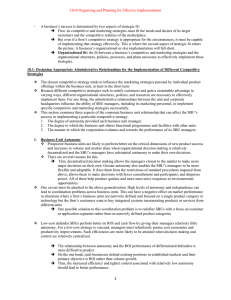BSAD231_ch2
advertisement
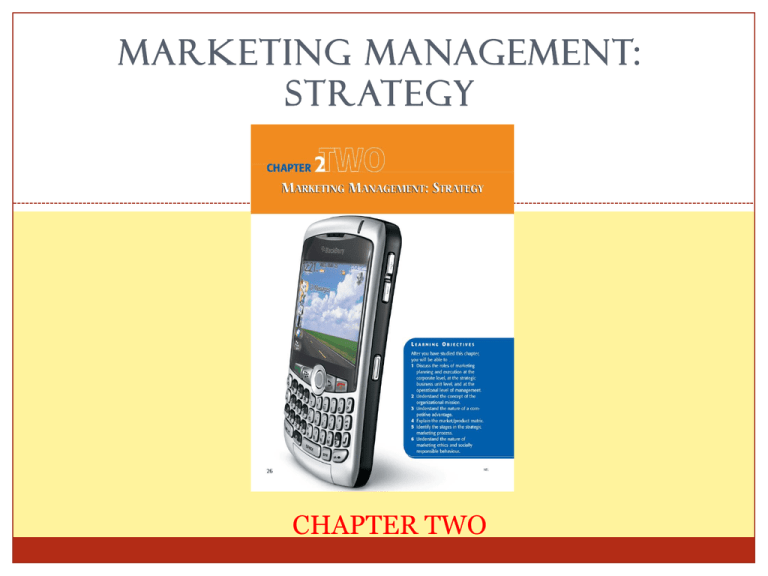
MARKETING MANAGEMENT: STRATEGY 1 CHAPTER TWO Marketing Management The process of: 1. planning, 2. executing, and 3. controlling marketing activities to attain the marketing goals and objectives effectively and efficiently. Change is constant and therefore the process is a continuous process. What is a marketing strategy? A plan identifying what marketing goals and objectives will be pursued and how they will be achieved in the time available. Planning: A Framework for the Future Envisioning the Future Establishing goals and objectives Designing strategies to be implemented in the future Level of management planning 5 Top Management: Mission Statement A mission statement is: A broad statement of the company’s purpose Explains the purpose of the organization Provides direction for the entire company Walt Disney’s Mission “The Walt Disney Company is committed to balance environmental stewardship with our corporate goals throughout the world” http://corporate.disney.go.com/environmentality/mission_history.html Homework Question Page 52, question 6 The examination of mission statements Strategic business units (SBU) Operates as a “company within a company” A SBU is organized around some common element such as…. Industry Technology SBU Customer need Target Market Boston consulting groups growth-share matrix Commonly referred to as the BCG Matrix Develop to evaluate SBU’s performance based industry growth (vertical axis) versus relative market share (horizontal axis) Assists management to determine resource allocation Four categories: Stars, Cash cows, Dogs, Question Marks (see exhibit 2-3, page 34) GROWTH RATE (Cash Use) Boston consulting groups growth-share matrix HIGH LOW MARKET SHARE (Cash Generation) HIGH LOW STAR QUESTION MARK CASH COW DOG Marketing Strategies at the SBU LEVEL 1. Marketing managers focus on two key aspects of SBU strategies: Establish a competitive advantage 2. Superior to or favourably different from competitors Examples include: price leadership, differentiation strategy Plan growth strategies (Visit Exhibit 2-5, page 37) Planning business-unit growth strategies The Market/Product Matrix (Exhibit 2-5) Markets Products Existing Existing New Market Penetration New Market Development Product Diversification Development 12 What’s Happening? http://www.theglobeandmail.com/report-on- business/industrynews/marketing/adhocracy/toyota-matrixcampaign-shows-peril-of-pullingpranks/article2168041/ http://www.youtube.com/watch?v=eH3GH7Pn_eA http://www.youtube.com/watch?v=V3WtXZGiav0& feature=related The six stages of the Strategic marketing Process Planning stages 1. Identifying and evaluating opportunities 2. Analyzing market segments and selecting target markets 3. Planning a market position and developing a marketing mix strategy 4. Preparing a formal marketing plan 5. Executing the plan 6. Controlling efforts and evaluating the results Stage One: Identifying and Evaluating Opportunities Situation Analysis: two major components: 1. Environmental scanning & monitoring External forces and trends are identified as opportunities and threats Forces include: sociocultural, demographic, economic, etc. 2. Internal analysis Internal strengths and weakness are identified Key topics include: organization, customers, suppliers 15 Stage One: Identifying and Evaluating Opportunities Bringing the internal and external analysis together: S.W.O.T Internal Micro-environment External Macro-environment Strengths Weaknesses (build on) (deal with) Opportunities Threats (take advantage) (avoid) 16 Stage Two: Analyzing Market Segments & Selecting Target Markets Consumer Market (B2C) vs. Organizational Markets (B2B) (Visit exhibit 2-8, page 42) Market segment Portion of a larger market (i.e. French Canadians) Market segmentation Dividing the mass market into smaller groups with similar characteristics that are likely to become the target market Target market The specific group(s) the organization directs its marketing mix towards Stage Three: Market Positioning and Marketing Mix strategy Market position: How consumers perceive a brand relative to its competition Developing marketing mix (4P’s): Product Price Place (distribution) Promotion Recall from Chapter 1? Homework Question Page 52, question 11 “How is Dr. Pepper positioned relative to Coke and Pepsi?” Stage 4: Preparing a Formal Marketing Plan The yearly marketing plan is a written report that includes: Marketing objectives (S.M.A.R.T) Marketing strategies Marketing mix Responsibility allocation Implementation timeline Stage 5: Executing the marketing plan Putting the plan into action! Management best practices: Ensure resources are properly allocated Clearly understand and communicate goals and expectations Create reasonable expectations and deadlines Stage 6: Controlling efforts and evaluation results Marketing Audits: Ensure that planned activities are executed properly Benchmark: establish performance standards Supervision: investigate to ensure tasks have been completed “checking up” Adjustments: evaluate to determine if goals have been achieved Yes? Continue with the plan No? Make adjustments and monitor Ethics and Responsibility Worldwide consumerism and environmentalism movements exert pressure for greater responsibility Notion of “caring capitalism” tied to the marketing concept. Seeking ways to make a profit by serving the best long-run interests of customers and communities.
